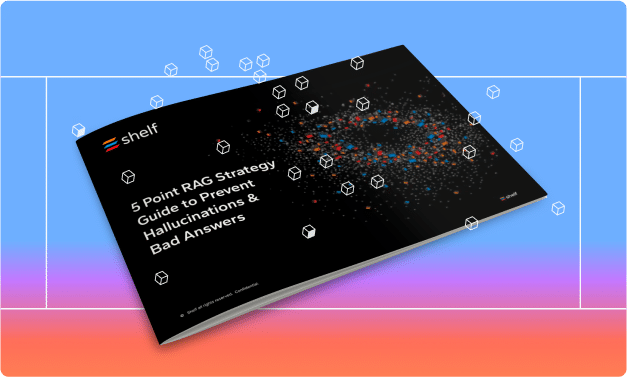Poor data quality is the largest hurdle for companies who embark on generative AI projects. If your LLMs don’t have access to the right information, they can’t possibly provide good responses to your users and customers. In the previous articles in this series, we spoke about data enrichment, identifying data risks, filtering out bad data, and fixing the data in your knowledge source. In this article, we’ll talk about the final strategy: continuously monitor your RAG system’s performance to ensure it’s always generating accurate, relevant, and unbiased information.
Let’s discuss four ways you can monitor your RAG system, ensure it works at an optimal level, and improves over time.
User Feedback Collection
The most important aspect of the monitoring process is the collection of user feedback—a direct line of communication between the system and its human users.
Implementing a user feedback collection mechanism is akin to installing a feedback loop within the RAG system, enabling users to express their satisfaction levels with the answers provided.
This mechanism can take various forms, ranging from simple binary options such as thumbs up/thumbs down to more granular numerical rating scales. The goal is to empower users to convey their sentiments regarding the relevance, accuracy, and overall usefulness of the generated responses.
By aggregating and analyzing the feedback received, valuable insights emerge regarding the system’s performance from the perspective of its end-users. Patterns and trends in user satisfaction—or dissatisfaction—can surface. This helps us understand areas where the RAG system excels and, crucially, where it falters.
These insights serve as guideposts for targeted improvements, whether they entail refining the content of retrieved knowledge (fixing it at the source) or fine-tuning the underlying algorithms driving the generation process.
In essence, user feedback collection serves as a vital feedback mechanism, bridging the gap between AI systems and human users. It empowers stakeholders, including IT professionals and data scientists, to actively participate in the enabling you to continuously monitor your RAG systems, ultimately driving towards the production of higher-quality outputs.
Examples of Feedback Collection Systems
Here are a few examples of user feedback systems that can be integrated into RAG.
Thumbs Up/Thumbs Down
This is one of the simplest forms of feedback collection, where users are presented with the option to indicate whether they found the generated response helpful or not. Users can click on a “thumbs up” icon if they are satisfied with the answer or a “thumbs down” icon if they are not.
Star Rating System
A more nuanced approach involves a star rating system, where users can assign a rating based on their satisfaction level. For instance, users may rate the response on a scale of 1 to 5 stars, with 1 star representing poor satisfaction and 5 stars indicating high satisfaction.
Likert Scale
This system utilizes a Likert scale, which consists of a series of statements or questions to which users can express their level of agreement or disagreement.
For example, users may be presented with statements like “The response addressed my query accurately” or “The response was relevant to my needs,” and they can select from options like “Strongly Agree,” “Agree,” “Neutral,” “Disagree,” and “Strongly Disagree.”
Open-Ended Feedback
In addition to structured feedback mechanisms, providing users with the opportunity to submit open-ended comments or suggestions can yield valuable qualitative insights.
Users can type their thoughts, criticisms, or suggestions into a text box, offering more detailed feedback on their experience with the RAG system, though addressing these concerns can be more time-consuming for your IT team.
Implicit Feedback Analysis
Beyond explicit feedback mechanisms, RAG systems can also leverage implicit feedback signals to gauge user satisfaction. This can include analyzing user behavior such as dwell time on a response, click-through rates on provided links, or subsequent search queries following an initial response. These implicit signals can provide valuable insights into user preferences and satisfaction levels.
Content Usage Statistics
To ensure that the RAG system is equipped with the most pertinent and impactful information, it’s essential to collect and analyze data on how different sections of the content repository are accessed and utilized.
Tracking the usage patterns of content within the repository provides invaluable insights into which sections are frequently referenced by the RAG system and which ones remain untouched. This data offers a window into the preferences and priorities of the system, guiding decisions on content curation and refinement.
Prioritizing High-Impact Content
One key implication of content usage statistics is the ability to identify high-impact content—sections of the repository that are frequently accessed and referenced by the RAG system. These high-impact sections represent critical sources of information that significantly influence the generated responses.
Prioritizing the accuracy, relevance, and comprehensiveness of high-impact content is important, as improvements in these areas will yield benefits to the overall performance of the RAG system. By ensuring that the most frequently referenced content is of the highest quality, the system can generate more accurate and relevant responses, thereby enhancing user satisfaction and utility.
Iterative Refinement
Armed with insights from content usage statistics, you can embark on an iterative process of content refinement and optimization. This process may involve:
Content Validation
Content validation involves verifying the accuracy and currency of the information contained within high-impact content sections. This process ensures that the content reflects the most up-to-date knowledge and insights available. Here’s how it works:
- Accuracy Verification: Review the information within high-impact content sections to confirm its accuracy. This may involve fact-checking or cross-referencing with authoritative sources.
- Currency Assessment: Verify that the information within high-impact sections remains relevant and reflective of the latest developments in the field.
- Update Implementation: Update the content accordingly. This may involve revising existing content, adding new information, or removing obsolete content.
Content Expansion
Content expansion involves identifying gaps in high-impact content sections and proactively enriching or expanding these sections to provide more comprehensive coverage of relevant topics.
This involves analyzing user queries, feedback, and usage patterns to pinpoint gaps in coverage. Then, instruct owners of the content to fill in the missing gaps with new information.
Content Removal/Archiving
Content deletion or archiving involves assessing the usage patterns of less-referenced content sections and determining whether they warrant retention or should be removed to streamline the content repository. Here’s how it’s managed:
- Usage Analysis: Content usage patterns are analyzed to identify sections of the repository that receive minimal or no usage. This may involve tracking metrics such as access frequency, page views, or user engagement metrics.
- Relevance Assessment: Next, assess the relevance and importance of less-referenced content sections. This involves evaluating whether the content remains pertinent to the needs of users or if it has become outdated or obsolete over time.
- Decision Making: Based on the analysis, make decisions regarding the retention, deletion, or archiving of less-referenced content sections. Irrelevant or unuseful content may be removed from active circulation to declutter the repository.
By implementing these content optimization strategies, you can ensure that high-impact content remains accurate, comprehensive, and relevant, while streamlining the content repository to enhance usability and accessibility for users.
Content Gaps Identification
The next component of your continuous monitoring program is the identification and remediation of content gaps within the knowledge source.
Content gaps represent areas where the RAG system struggles to provide satisfactory answers due to missing or inadequately detailed information in the source content. By systematically identifying and addressing these gaps, you can bolster the comprehensiveness and accuracy of your content repository, thereby enhancing the RAG system’s ability to deliver meaningful responses.
Reviewing Unanswered Queries
One method for pinpointing content gaps is to review queries that the RAG system fails to answer effectively, replies with “No Answer,” or fails to generate any response at all. These queries represent instances where users pose questions or seek information that the system cannot adequately address due to gaps in the available content.
These instances signal areas where the system lacks sufficient information to generate a meaningful response, thus exposing gaps in the content repository. If you examine enough of these unanswered queries, eventually patterns will emerge that show you where your knowledge source is missing information.
For instance, consider a scenario where a user asks, “What’s the price?” If the RAG system fails to provide a satisfactory response because the necessary pricing information is absent from the content repository, it highlights a content gap in the area of pricing details.
But if the RAG also fails to answer questions like, “What color is the product?” or “How big is the product?” you may have a general gap in regards to product data. It would be smart to look at all of your product data to identify and repair holes.
Content Enhancement (Closing the Gaps)
Identifying content gaps is the first step. Next, you need to take steps to systematically fill in missing information and address deficiencies in the knowledge base. This may involve:
- Content Enrichment: Adding additional details, explanations, examples, or context to existing content entries to enhance their relevance and completeness.
- Research and Data Acquisition: Conducting targeted research to gather new information or data points that address specific content gaps identified through user queries.
- Collaboration with Subject Matter Experts: Engaging subject matter experts to contribute their insights and expertise to the content gaps, ensuring accuracy and depth of coverage.
- Content Curation: Curating relevant external sources or authoritative references to supplement existing content and provide comprehensive coverage of relevant topics.
By systematically addressing content gaps through these enhancement strategies, you can fortify your content repository and equip the RAG system with the knowledge and insights necessary to provide more comprehensive and accurate responses to user queries.
Time Series Analysis
RAG systems are not static. They should evolve over time. To effectively monitor and optimize the system’s performance, it’s smart to leverage time series analysis: an analytical approach that examines usage data and user feedback trends over time.
This method helps you track the trajectory of the RAG system’s performance, identify anomalies, measure the impact of changes, and ensure continuous improvement.
Monitoring Performance Trends
Time series analysis involves tracking usage data and user feedback metrics over successive time intervals, such as days, weeks, or months. This gives you insight into performance trends and patterns so you can identify any deviations from the norm.
For example, sudden drops in user satisfaction ratings or changes in content usage patterns may indicate emerging issues that warrant further investigation.
Identifying Anomalies and Root Causes
Anomalies detected through time series analysis serve as valuable early warning signals, prompting you to delve deeper into the underlying causes. For instance, a decrease in traffic to certain content sections may indicate user dissatisfaction with the provided answers.
By examining changes in usage patterns alongside user feedback, you can pinpoint root causes and take corrective action to address concerns promptly.
Measuring Impact of Changes
Beyond anomaly detection, time series analysis allows you to evaluate the impact of changes and improvements made to the RAG system or content repository. For example, if adjustments are made to the underlying algorithms or content curation strategies, you can track how these changes affect performance metrics over time.
Continuous Improvement
The iterative nature of time series analysis fosters a culture of continuous improvement, where you leverage insights gleaned from performance data to inform strategic decisions and refine the RAG system iteratively. This lets you adapt to evolving user needs, address emerging issues, and capitalize on opportunities for enhancement.
An Ongoing Process
Continuously monitoring and improving RAG systems is important to ensure the delivery of accurate and relevant responses to user queries. By implementing user feedback collection, analyzing content usage statistics, and identifying and addressing content gaps, you can drastically improve the quality of your data and enhance the overall performance of your RAG solution over time.




